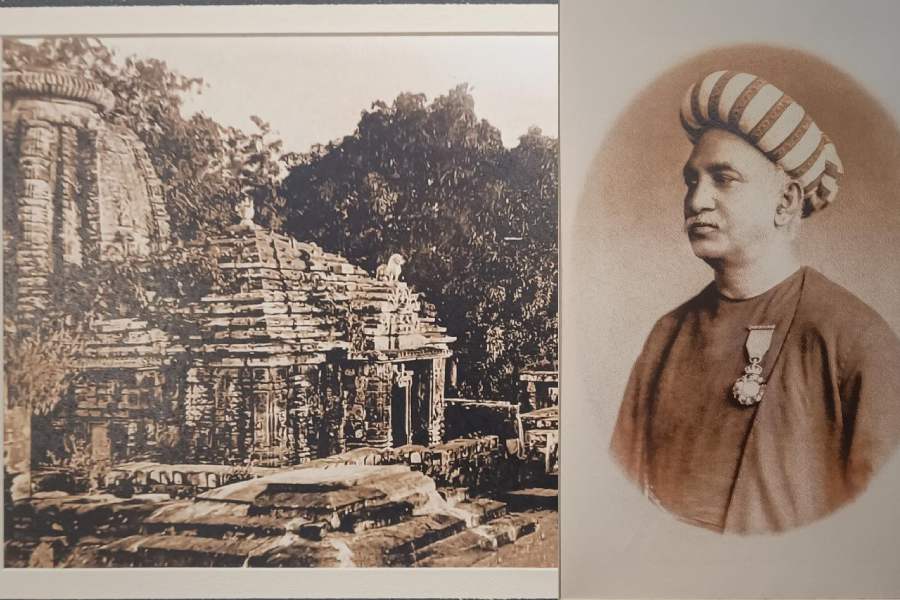The series of eight enlarged photographs of temples on display in Calcutta looked familiar. The photographs were black and white, sepia-tinted, but crystal clear. They had been taken sometime in 1868/1869. But the bigger surprise was the man who had taken them, poly-math Rajendralal Mitra. Very few remember that the Indologist and historian was also a photography pioneer.
Mitra is best known for his more than 40-year-long connection with The Asiatic Society of Bengal, initially as an assistant secretary and librarian (he took up the job in 1846 at a salary of ₹100) and eventually as president (1885-1886). A man who knew Sanskrit, Persian and Latin apart from Bengali and English — and had a working knowledge of French, German and Greek — Mitra had 184 papers published in the Journal of the Asiatic Society.
When you come to think of it, it was perhaps only natural that Mitra would be the one to take some of the daguerreotypes that illustrate one of his most important books, The Antiquities of Orissa, a seminal work on the architecture and socio-cultural traditions of temples. The daguerreotype was the first commercially successful photographic process that used silvered glass plates to capture the photo and is named after its French inventor. In Mitra’s book, the photographer is not credited.
“It was Shyamal Guha, son of photographer Charu Guha, who came upon the original photographs in the National Library in the 1980s and discovered that they had been shot by Mitra himself,” says Debashis Dutta, the man who had organised the exhibition of Mitra’s prints at the BoiChitra gallery in the Indian Coffee House on College Street. The occasion was Bengal Photography Day, celebrated to mark the setting up of the first photographic society in the country, the Photography Society of Bengal, in 1856.
In 2020, a century and a half after Mitra, Dutta decided to revisit the temples Mitra had photographed. Although temples are usually thronging with pilgrims, Mitra’s shots are free of humans. Dutta just wanted to click the same structures, he had no plans of reconstructing Mitra’s frames. “But when I looked at my prints, they looked strangely familiar. I realised then that Mitra had shot the temples in eastern light, just like me,” says Dutta.
Taking photographs was a major undertaking during Mitra’s time, according to Siddhartha Ghosh’s Bengali book on the practice of photography, which chronicled the early days of the art and its star practitioners. One had to travel with tonnes of equipment — a camera that was bigger than today’s movie cameras, glass plates on which pictures were taken, the necessary chemicals to coat the glass plates and even a darkroom tent to develop photos on the spot so that a bad one could be retaken.Mitra would not have had trouble with the manpower needed because he was travelling through Orissa (now Odisha) studying its architectural and religious marvels on official business of the Asiatic Society.
“Mitra was the honorary secretary, and later treasurer, of the Photography Society of Bengal,” says Dutta. Mitra’s obituary in the Hindoo Patriot in 1891 reads, “he was one of the best photographers of his day”. Going by his papers published in the journal of the photographic society, Mitra was extremely interested in the technical aspects of photography.
“Unfortunately, Mitra was forced out of the society by some Englishmen because he supported the Black Act of 1836,” says former photojournalist Jayanta Sau. The Black Act referred to Macaulay’s Act of 1836, which decreed that the same laws would govern both native and European subjects of the East India Company. At that point of time, about one-third of the 100-strong society’s members were Indians. All except two resigned in protest againstMitra’s removal.
That speech by Mitra in February 1857 in the Town Hall nearly got him killed. A few irate Englishmen had planned to do away with him on the way home, but a friend of Mitra’s overheard their plans and spirited him away in his own carriage. Ghosh has recounted this story in his book.
The photographic society incident was among many setbacks that Mitra faced. One of six sons to a father who did not have the means to educate them, Mitra was the brightest and was put through school in Calcutta by his widowed aunt, who then died unexpectedly, putting a stop to his education.
The bright young man was advised to apply to Calcutta Medical College where a free education was available for the asking. Mitra studied there from 1839 to 1841, when he was expelled for refusing to snitch on trouble-mongering classmates. The man who rusticated him, a Dr Moet who was then principal of the college, was also the moving force behind his expulsion from the Photography Society of Bengal some years later, points out Ghosh.
Impressed with his brilliance, Dwarakanath Tagore offered to send Mitra to England to complete his medical degree but his father refused the offer because of caste prejudices. After being disappointed in his medical studies, Mitra started preparing for the law exam and even appeared for it. Unfortunately, the exam was cancelled because the paper had been leaked.
In dire straits financially, Mitra decided against reappearing for the exam and started looking desperately for a job. Eventually, he got the one with the Asiatic Society and it shaped his studies as well as how history sees him today.










